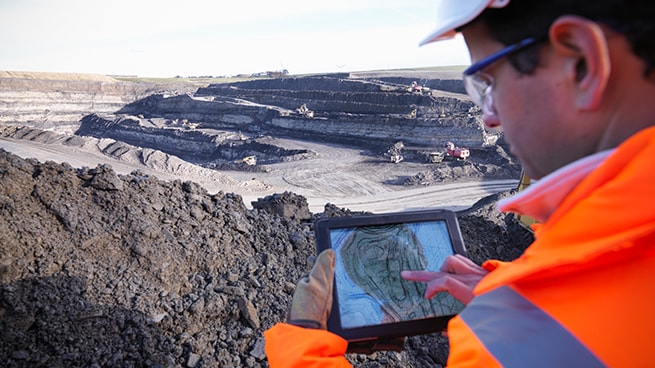
Buoyed by high commodity prices, a positive business outlook and, in many cases, rising cash reserves, miners are eyeing opportunities to use their recent successes to invest in future growth. Many see opportunities to reduce production costs, improve employee safety and address environmental, social and governance (ESG) matters while also managing increased regulations, depleting mineral reserves and other issues outlined in our Canadian Mine 2021 report.
We’re already seeing many miners investing in Industry 4.0 capabilities and automation solutions to respond to these trends. Artificial intelligence and the Internet of Things are informing new solutions, such as predictive maintenance, integrated planning simulations and optimization, digital twins and robotics for agile operations, which let miners scale production up or down as commodity prices fluctuate.
Closing the ROI gap
But too often, digital initiatives yield a lower return on investment than hoped. Available data can go underused because collecting and analyzing it takes too long to inform timely decision-making. In other cases, information coming from disparate systems tells an incomplete story of a miner’s operations. And even the best-designed technology initiatives can fail to gain traction when layered on broken business processes or implemented without employee buy-in.
The key to getting more from digital initiatives involves uncovering ways to make even better use of existing technology investments while embracing further changes that create more value. A critical part of this journey will be improving coordination and collaboration across the organization and developing, enhancing or refining a data strategy to generate the insights you need to improve your operations.
Here are a few areas where mining companies can start:
1. Take a closer look at current data assets
Miners are generating more data through their equipment and software platforms than ever before. Before making large investments in new technologies that will create even more information, it’s helpful to pause and look for opportunities to use what you already possess to make better—and more timely—decisions. Some examples include:
✓ Data analytics: There are limits to the amount of analysis individual employees can perform as the volume of data you’re generating multiplies. Automated tools can produce meaningful insights that can help create more value from mining operations.
✓ Cloud storage: Centralized storage makes data more accessible to both operational and business leaders than housing it in different on-premises locations.
✓ Data convergence: Historically, the numerous software platforms that help run various parts of a mining operation rarely connected with each other. But that’s changing. New enterprise resource planning (ERP) systems and operational platforms integrate multiple sources of information from across an organization, tying disparate data sources together to tell a compelling story.
2. Embrace quick wins
Some mining companies may perceive all digital transformation initiatives as cumbersome and expensive undertakings. But there are often low-cost solutions that drive improvements to key performance indicators such as profitability, health and safety metrics, cost per tonne of production and ESG targets.
For example, we’ve seen companies use existing technology to create a simple reporting dashboard showing a miner’s performance for the previous day. By getting key information, such as tonnes lost the day before, to operators, it’s possible to generate meaningful productivity improvements.
These incremental steps that deliver quick wins can add up to bigger improvements over time for smaller mining companies and larger enterprises alike. And miners can often scale them to fit their size and needs as they grow.
How to move beyond digital
Digitization is a top priority for many mining executives. According to our 2022 CEO Survey, 49% of top executives at global mining and metals companies say they include automation and digitization goals in their long-term corporate strategy.
While these digital investments are critical for many miners to achieve their organic growth, operational efficiency and ESG targets, winning in today’s world requires more than digitization. Increasingly, miners must build unique capabilities that help them deliver value in a unique way. And this requires embracing a holistic journey that considers all elements of transformation. They include:

Strategy: Start by reconsidering your strategy and what drives value for the business. Without this step, you may end up making changes before you’ve decided on what you’re looking to achieve. This is key to assessing where you need to invest and what the most promising opportunities are so you can build the capabilities that will deliver on your strategy. A strategic vision is a critical part of defining a business case prior to proceeding with any technology implementation. This makes sure your decisions support your capabilities rather than playing the game of investing in every technology solution.

Cross-functional alignment: While technology can deliver significant benefits, it can’t fix a broken process. To truly make a difference, it’s important to develop a clear, cross-functional agenda for achieving your goals based on conscious choices for streamlining processes across the organization. This includes bringing different parts of the business—including procurement, operations and finance—into the decision-making and implementation process. Without broad buy-in at the start, user adoption can lag and subsequently reduce the value achieved. Now more than ever, miners need to take an integrated, value-stream approach to process improvement with all functions aligned to their goals.

Reorganizing for growth: Automate low-value tasks where possible. This can reduce costs and free up your employees to use their skills analyzing data and generating business insights—rather than extracting, compiling and manipulating data—that help support your strategy and sustain the momentum for change.

Building digital trust: Adopting new technology solutions is opening new opportunities for miners to explore and use data. But it can also create complex cybersecurity challenges.
Mitigating these threats requires miners to understand their risks and implement security solutions that address their vulnerabilities in a comprehensive and integrated way. This is critical to ensuring the success of digital investments and mitigating risks that can erode trust and hold back growth.

Creating the mining workforce of the future: We believe a critical element of success lies in combining human ingenuity with technological innovation. This doesn’t always come easily. Some miners struggle to bring their workforces along with them on the change journey as they look to accelerate digital adoption. But we’ve seen organizations successfully overcome this change management challenge by being mindful of the pace of transformation and employees’ ability to absorb it. Introducing new processes and systems gradually—by, for example, bringing in one new key performance indicator per month—can still quickly lead to meaningful and sustained outcomes.
More broadly, it’s important to revisit your workforce strategy to ensure you have the skills you need. This is especially important as miners adopt technology-enabled solutions while managing key challenges like an ageing workforce nearing retirement and the need to attract new employees amid a fierce war for talent. Focusing on developing the right cultural attributes can be an important tool in attracting and retaining talent and maximizing the organization’s potential.
Embracing new opportunities to shape the future
By following this path, miners can focus their efforts on changes that will help them thrive in the long term. This can also help miners shift resources and costs away from areas that are no longer a priority, which they can then reallocate to their investment priorities.
For further perspectives on today’s evolving transformation agenda, read our latest insights into how executive teams can lead in the digital age. And to discuss your organization’s path to long-term growth, please contact us any time.

Contact us


Subo Chatterjee
Partner, Digital Operations, Industry 5.0 and OT/IoT, PwC Canada
Tel: +1.647.890.2566


















